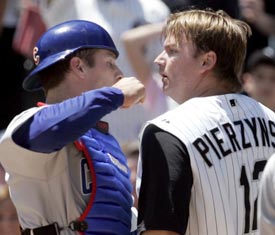With
Coco Crisp's return from the DL aimed for Monday's matchup with the Blue Jays, one monumental question has yet to be answered -- where will Coco go?
The Red Sox have four legitimate, everyday-quality outfielders, as well as a couple capable backups in
Willie Harris and
Dustan Mohr. And though we love
Manny,
Coco,
Wily Mo, and
Trot, the fact remains that there's only room enough for three. None of these guys figure to tolerate riding the pine, which means that unless Pena and Nixon platoon in right, one must be the odd man out -- of Boston.
And of course the first instinct
is to have Nixon and Pena platoon in right, but this turns out to be a very inefficient solution. Pena is thriving with so many at-bats, and Nixon is hitting well thus far too -- in fact, their averages, homers, runs scored and RBI are nearly identical. But cost is going to be a large factor in this proposed solution, and no team can feel good with a $7.5 million situational hitter. To cap it off, this platoon would make absolutely no sense from a baseball standpoint either. Isn't
one of the two players
supposed to be able to hit a lefty? Well, yeah. And for as bad a rap as Trot gets, his splits are acutally much improved from previous years. Pena, the proposed lefty-masher, has an ugly split this year, hitting .190 off southpaws. If the ultimate decision is for Nixon and Pena to "share time" in right, it would be at least tolerable. The justification for a platoon here just doesn't exist.
So, if you want to effectively spend $10 million on a right fielder with a good average and a hit-or-miss power stroke, stunt Pena's development and fail to reap the full benefit of Trot's contract year, feel free to put Wily Mo Nixon in right. Somehow that just doesn't seem like the most viable option, though. And with Manny and Crisp all but set in stone in center and left, it's too small for two in right. Especially with Wily Mo Pena there. But to trade Trot?
Unthinkable -- at first, anyway. But the more you think about the possibility, the more appealing it becomes, for a slew of reasons. Trot has good trade value that's been getting even better thanks the the impressive numbers he's been posting. He's in the last year of his contract, a trading win-win: we would receive compensation for him where he would otherwise have walked, and he will be especially attractive to suitors for lack of a cumbersome contract.
What kind of a deal would the Sox pull? That would depend on how many other variables played out, but no matter how the cards fall there will be any number of possibilities. Potential trading partners? Teams with 1)money, 2)a chance at the playoffs, and 3)need for an OF. We can only imagine a few:
Houston Astros: a poor outfield isn't helping the Astros chances in the NL Central, where they are already 6 games back. The Sox would definitely be interested in
RHP Equiziel Astacio, or farther down,
LHP Troy Patton.Texas Rangers: Don't necessarily need Nixon in the outfield, but could use some stability from the DH.
RP Akinori Otsuka would be highly-coveted by the Red Sox if they would rather get immediate bullpen help. If they can wait, Texas has an abundance of minor-league righties to offer, as well as minor-league
OF Freddy Guzman and
SS Joaquin Arias.
St. Louis Cardinals: The outfield could use some bolstering for the playoff run, and though
RHP Anthony Reyes is likely (or at least should be) untouchable, righty
RP Adam Wainwright would fit nicely into the Sox pen. The Cardinals' top 6 prospects are all RHPs, so trading one wouldn't hurt as much as it might other teams.
LA Dodgers: They have a decent outfield, but it taking on Nixon in the playoff hunt would be a significant upgrade.
3B Andy LaRoche would be a nice additition to the farm.
San Diego Padres: The upgrade to Nixon (with the Red Sox assuming some contract) could net
C George Kottaras (
Varitek isn't getting any younger). For immediate help, right-handed releiver
Scott Cassidy would be downright stingy near the back of the bullpen.
To trade Nixon, the Sox' second-longest tenured player, would be to go against every natural instinct of a Red Sox fan. But if it feels wrong to trade Trot, it feels... wrong-er to keep him. Especially with
Roger Clemens narrowing down his choices as he prepares for a comeback, the $7.5 million would just be much better-spent elsewhere than on a part-time right fielder.




